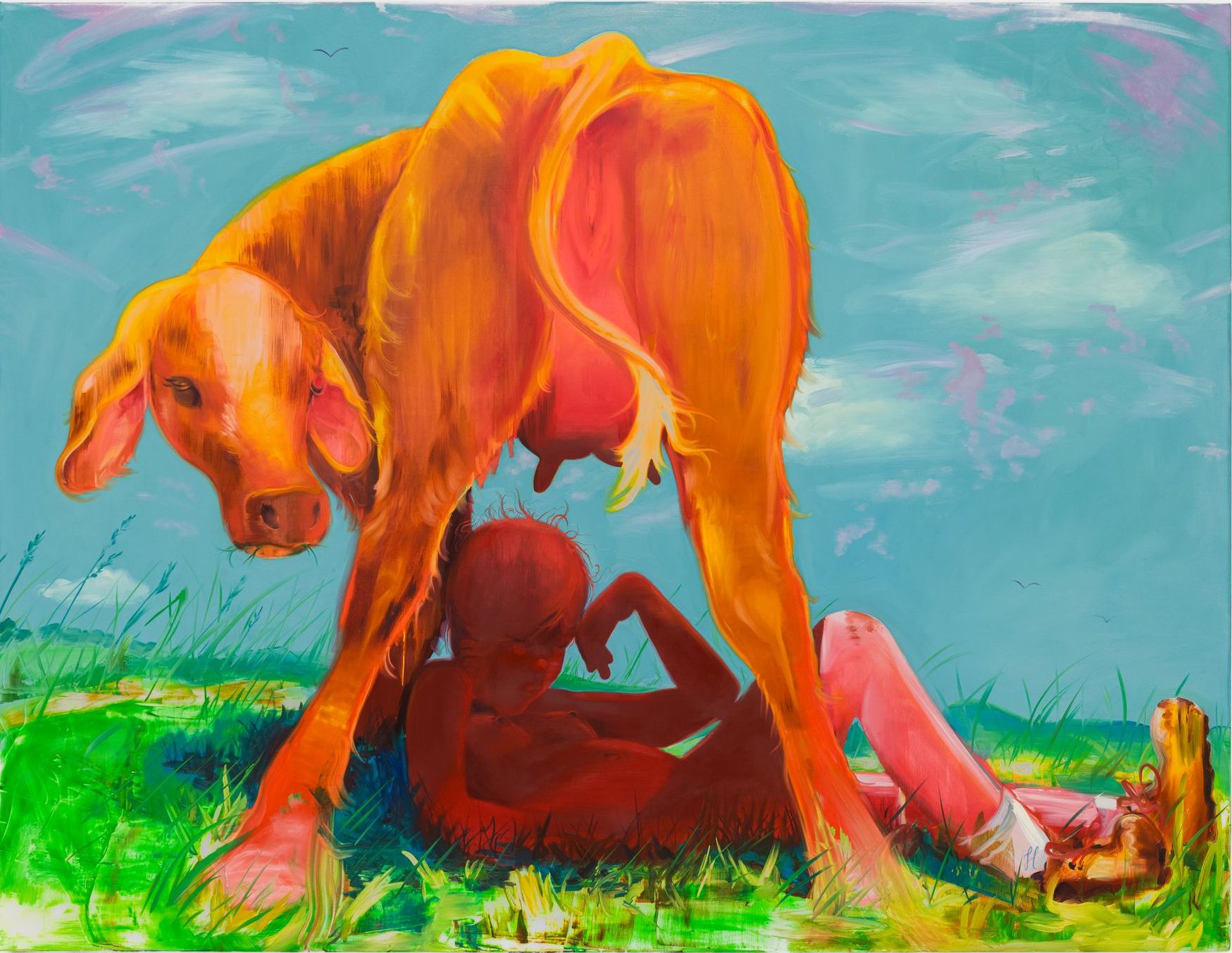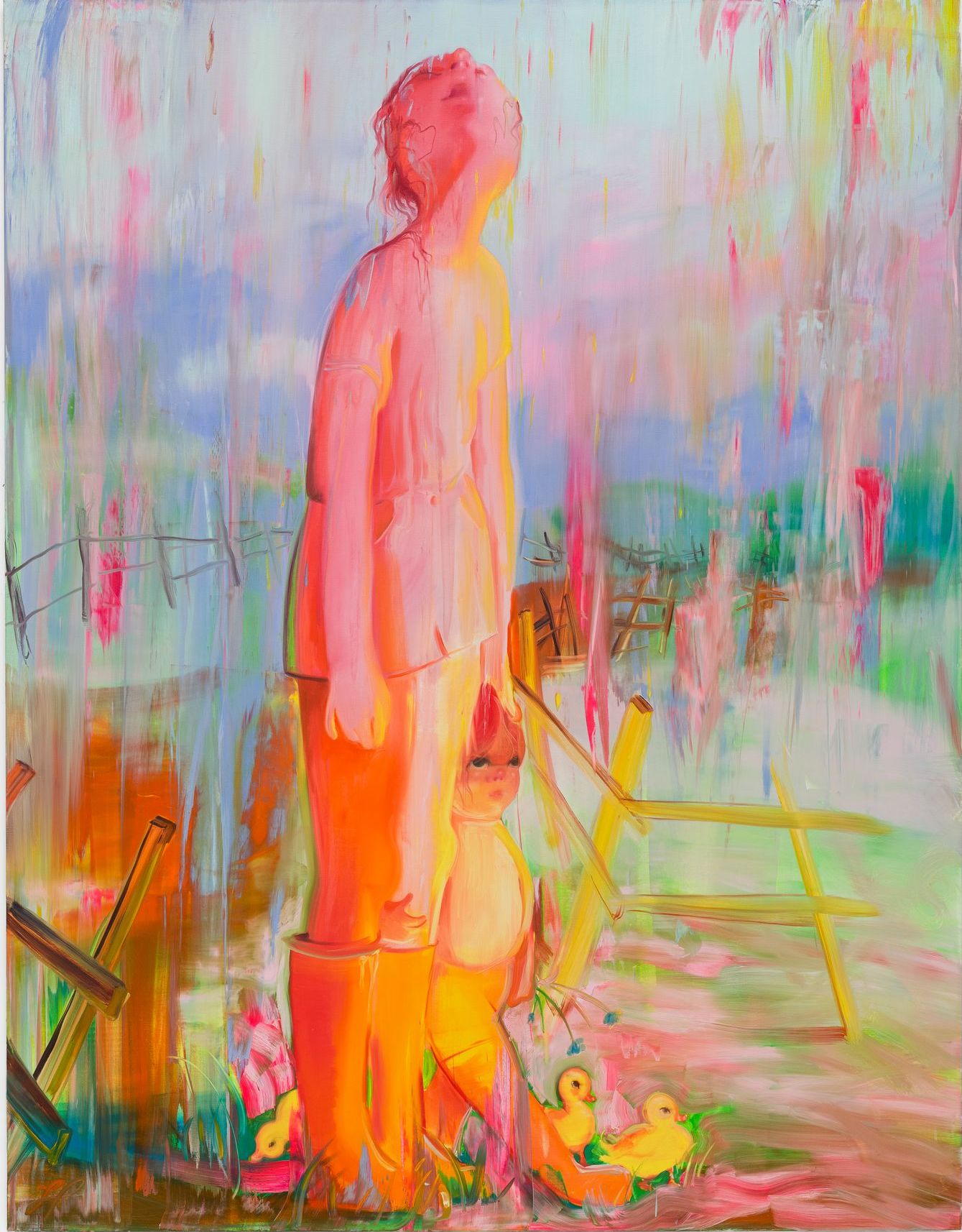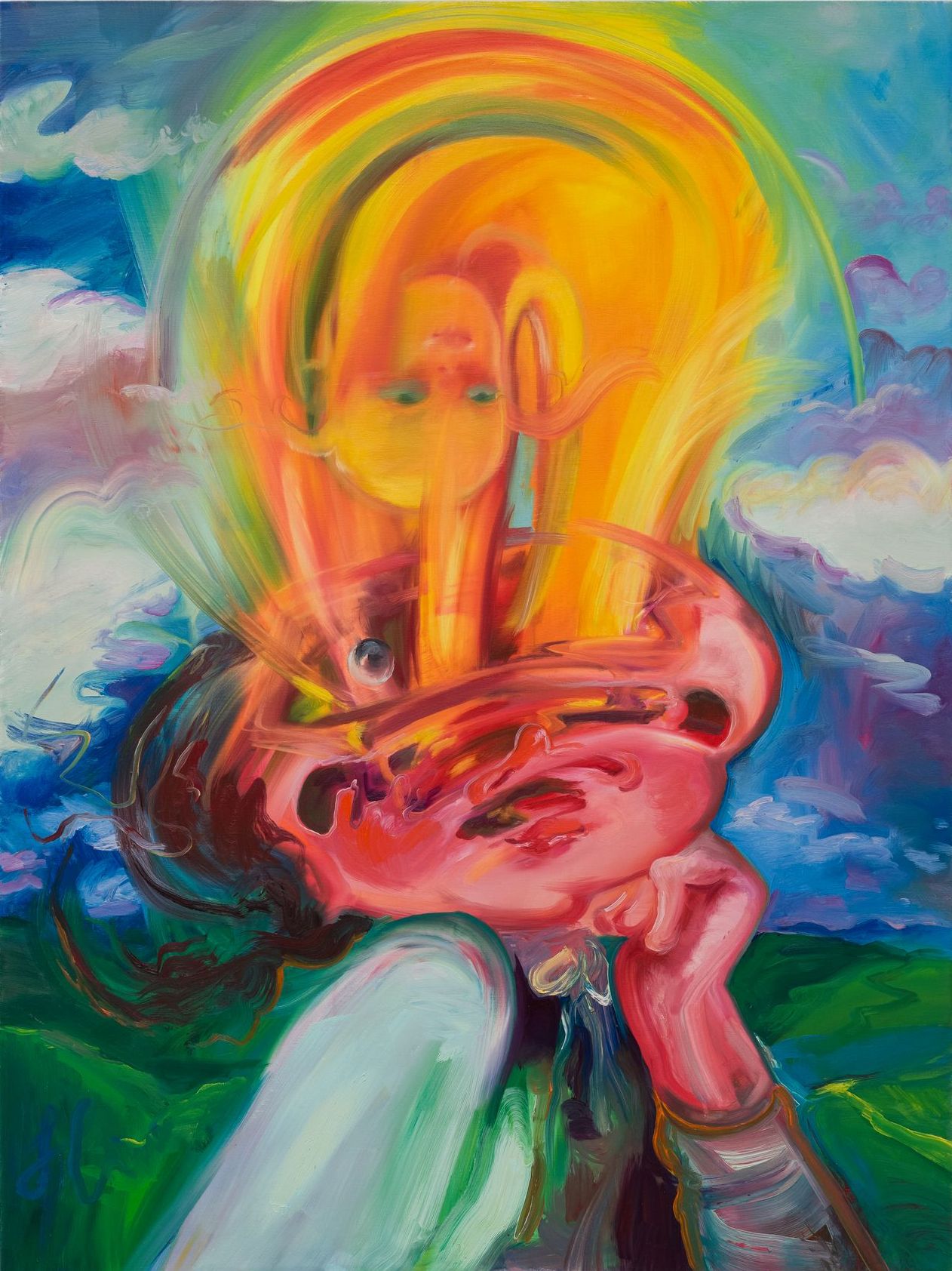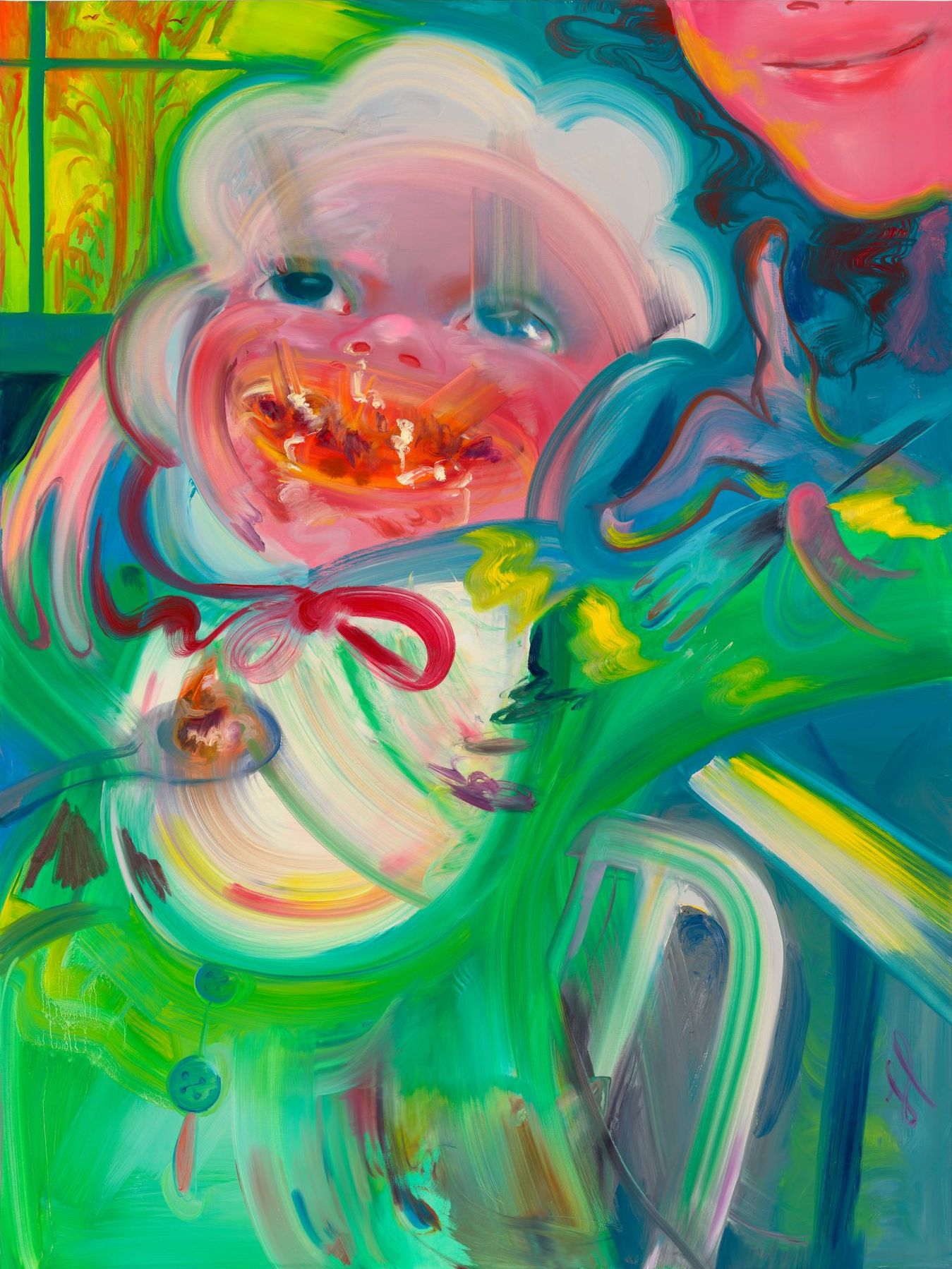
The surreal and incandescent large-scale paintings of Haley Josephs provide a radiant overwhelming sensorial experience that seeks to immerse the viewer in the vast mysteries of being – awakening us from the grey sub-reveries of day-to-day existence to the phenomenology of what the philosopher Eckhart Tolle might refer to as authentic presence in the moment. Her latest solo show at London’s Almine Rech Every Part of The Dream invites us on a luminescent journey from birth to adulthood that takes into its hypnagogic sway everything from the very first experience of sunlight on a baby’s excitable face, to the head-exploding enlightenment of a lone traveller in a pastoral landscape, where true beauty provides a key to heightened phenomenological perception and pure identity. In this exclusive interview with Culture Collective, the artist gives us unique insight into the conceptual genesis of her latest series of paintings, and explains why the presence of ghosts from her childhood, and a sense of another realm of pure spirit, are core to her creative process.
What drew you to art as a form of expression as a child?
I have very early memories of how certain colours gave me a sort of sensory experience. I would draw all the time with crayons, and try to make combinations by putting colours on top of other colours, and I would get this feeling in my body that I felt I needed to chase, almost like an addiction – so, from an early age there was this strong attraction to to colour. But wanting to express myself came much later, when I was a teenager. It was when I went to art school that I started trying to figure out what I specifically wanted to focus on. I really started mining my family histories, and the depths of unspoken stories from my childhood, because when I was growing up, there was a lot of tragedy and violent death in my family on both sides.

It sounds like art was a kind of journey into an inner landscape …
I grew up with these stories of death and loss from a young age, because my sister died tragically right before I was born, and my aunt went missing. So, they were these unsolved mysteries, and I grew up with this very strong image of this woman walking off into the Montana wilderness in my head, never to be found. I was just reflecting the other day on the characters in my paintings, and I realised they've always been sort of the same. I started making paintings of this woman and my sister when I was in college, and I can still see them both in this work. I've always been painting those characters. These two people have become archetypes in my work, but also in my life. I think I have always wanted to celebrate their lives through paint.
So your late sister was always with you as a ghost sibling, in a sense?
I think that is exactly the feeling. I've always felt a strong connection to her, even though she isn't there. Also, even though she's my older sister, she's permanently young in my mind because she died young – so, in a sense, she's also like a younger sister; this little girl. It was not something I talked about, or could articulate in my work for many years. But I realise now that there was always this character that I felt was a bridge between this ethereal world and me. I've always felt that sense of a bridge between us – it’s like, I'm the one that's holding it down in the reality world, and then she's on this other side. Also, I grew up in Pittsburgh, where it's super cloudy and overcast, so, when I think back on my childhood, I was sort of in this dark place with these dark stories, and I felt like everything was in a fog. I was drawn to colour, and wanted to reveal what was out beyond the fog. I mean, looking back, I can say that now. I didn't really know at the time.

The show seems to be about the different stages of life’s journey …
Yeah. And it has to do with kind of celebrating the journey itself. There is no destination, but there is often a path in the work that symbolises the perpetual journey. So, with a lot of the characters, even if it looks like they're settled, there's always going to be this horizon, and there's moments of vastness shown through images of the sky and mountains, and I think that is an important reminder of our littleness in the world – a sense of the micro and the macro, and the importance of small, intimate moments within a whole cosmos that is so much bigger. I think a lot of my work has to do with a celebration of life, but with an honouring of that vastness, and respect of death and afterlife. I think that death and birth are so close together, because I feel a strong sense of this other side that sometimes comes into this reality – in a way, my work is about celebrating life, and honouring whatever comes.
Where do the images you employ to represent these ideas come from?
My work comes purely from imagination, and the best time for the visions to come to me is when I'm hiking. Being around nature is just really important for me, because, ever since I was little, being in nature, or near water, calms me. It always has. And I just feel like you can learn from nature. If I'm not in a forest, or if I'm not near the ocean or near mountains, I can at least look up the sky, and I feel like you can learn a lot from just looking at a cloud formation, from star gazing or looking at sunset or sunrise.

Where were you when these paintings came to you?
I was up in Maine when making these paintings – walking around a lot, and I was sort of seeing these reflective pools, and seeing a reflection of the mountains and the sky in the water. It made me think about how we exist a lot of the time in a kind of reflection that we think is reality. But I think that it's actually a dream, because if you have this moment of waking up, and seeing that you're actually in this beautiful place that's real in the moment, then that is more beautiful than the dream of reality in our minds. We're kind of always somewhere else, you know? We're always thinking about the past, or thinking about what's going to come in the future, and that's sort of living in a dream. But when you're truly in reality, you're awakened to this moment of true beauty.
Are you depicting that awakening in Head Cracks Open, Let God Come In?
Yeah. It was one of the first paintings I made for the show, because I kept seeing this figure in the clouds, and I felt like it was me, or was maybe like the characters I'd been painting, but it was sort of also morphing into this new being. It depicts this person who is witnessing the beauty of the surrounding landscape, and they're having this moment of awakening, and their true self is sort of bursting through their head and breaking free of their form body into this ethereal sort of being – one can't literally paint something like that, but that I tried to make a painting of it by representing the bursting of that energy going through the head.

There’s a similar kind of energy to Food Sloshing in Baby’s Mouth / Sunlight Through Window – a sort of explosive awakening …
Food Sloshing in Baby's Mouth is the very first painting I made in the show. It also is starting point of the journey, as it is a young baby. It's kind of good for the journey to begin there. It’s a really sensory painting. The baby is eating, and it's super excited, and I was just trying to think about how a new body reacts to new sounds and flavours and temperatures in a way that a body like ours really can’t, because we have so much history behind us, and nostalgia. To a baby everything is brand new, and they're feeling things for the first time – how can can we even remember what it's like to experience a carrot for the first time, or whatever, and that first feeling of the sunlight on your skin and, and how that just feels so good.
Do you believe that our core identity is way beyond all of the narratives we build up about ourselves?
Definitely. Our form bodies all have a lot of stories, and they have birthdays and astrological signs and, you know, sexual preferences, and certain things that they like and don't like. But at the core of who we are is sort of just a ball of light, and this energy that is untouched by all of that. When I make a painting I feel the energy of being on kind of a journey, and then at the very end, it's sort of, like, oh, cool, I made that. I am not really at all attached to my paintings when they are finished. My work is really just driven by that fact that I love that energy I feel when making the paintings – that journey is so, so important to me. It's kind of a feeling that I'm hoping to share when people experience them. I would love for people to experience them like a warm hug – or feel that they are being encompassed by beauty, or a sense of vastness.
Images (top to bottom): Portrait of Haley Josephs in her studio by Dan Bradica; Golden Valley, 2022, copyright Haley Josephs; Summer Rain Shower Enter Rainbow Light, 2022, copyright Haley Josephs; Head Cracks Open, Let God Come In, 2022, copyright Haley Josephs; Food Sloshing in Baby’s Mouth / Sunlight Through Window, 2022, copyright Haley Josephs. All artwork images shot by Charles Roussel. All images courtesy of the artist and Almine Rech.